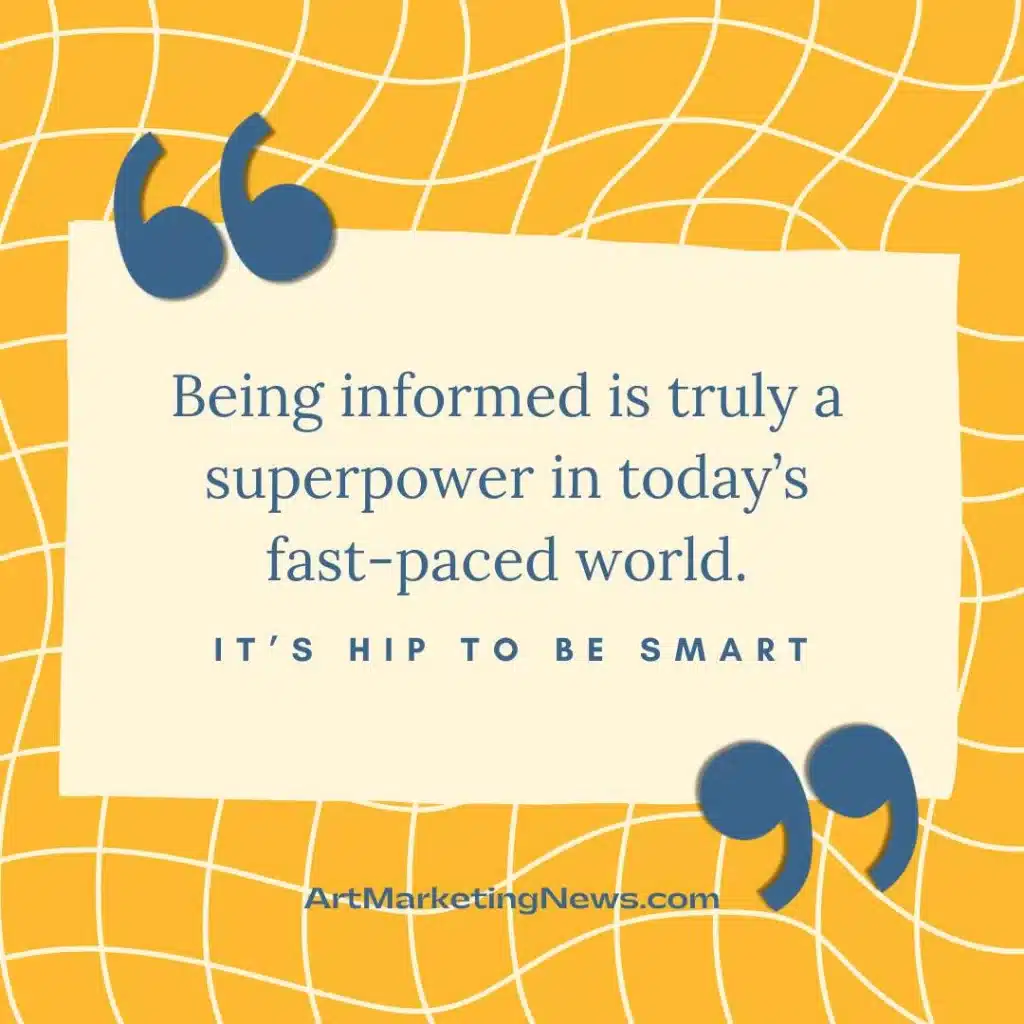
Art doesn’t sell itself, it has to be sold.
— Jack White

The question of what type of art sells best is complex. It’s nearly impossible to give a definitive answer because the art market is multifaceted. Are we talking about original paintings, sculptures, mixed media, digital art, or reproductions?
The art category greatly influences what’s popular, as do many factors. However, understanding current trends and best-selling styles can be a game-changer for your art marketing efforts. This knowledge can be invaluable, especially if you want to understand what resonates with buyers and how to position your work in the market.
The Impact of Knowing What Kind of Art Sells Best
Understanding what art to create is a crucial element of art marketing. For example, gaining specialized insight into current wholesale home furnishings market trends can give you a significant advantage, especially if your goal is to have your work featured in high-end retail stores and catalogs.
Your acquired market insights empower you, giving you the control and confidence to make informed decisions about your career path. Even if you aren’t pursuing the home decor market, understanding the decision-making processes behind design requirements, color palettes, and marketing presentations provides invaluable data. These insights can be priceless and will come in handy unexpectedly.
Cultivating a deep understanding of the broader art market can open doors you never imagined. The knowledge you gain today could lead to unforeseen opportunities tomorrow. If you want to know what kind of art sells best, it pays to be curious about the art business around you. It will make you more innovative and efficient about everything you’re doing to get your work to market.
Florals and Landscapes Remain Popular
I was an executive at Decor magazine for decades, the leading business publication for art galleries and picture frame shops at the peak of the art poster and limited edition market’s incredible multi-decade dominant run. It was the experience of a lifetime. We annually surveyed our readers about their best-selling art, and landscapes and florals consistently topped the list.
Even though the surveys were done long ago, these classic themes remain just as appealing and versatile as they did then. Basic tastes vary, but they don’t change. That’s why, across generations, they fit seamlessly into various decor styles and, like abstracts, are generally considered non-controversial. But countless other styles, genres, and media have lucrative potential to explore.

The Power of Knowledge in the Evolving Art Market
Understanding top-selling art pieces is crucial for success across all genres, including niche styles like steampunk and fantasy art. And the sub-genres are vast. For example, how many kinds of religious art are there? Knowing market trends helps artists create works that attract collectors while staying true to their unique vision. Their awareness and appreciation not only enhance the visibility of your artwork but also increase its perceived value within the larger art scene.
Art Trends: What You Need to Know about Them
Moreover, being well-informed about current art market trends allows artists to engage more effectively with potential buyers. It empowers them to tailor their portfolios, making strategic decisions about which pieces to showcase during exhibitions or in online galleries. You want to be competent in deploying your assets, time, productivity, and creativity.
Such insights can also inform pricing strategies, ensuring that artworks are marketed competitively yet reflect their actual value. The savvy artist can leverage this information to enhance their narratives around each piece, making them items of aesthetic value and objects with compelling stories and cultural significance.
The Importance of Staying Informed in Niche Art Markets
In essence, remaining informed about art trends, especially in niche markets, is vital for any artist. It empowers them to navigate the complexities of the art world confidently, fostering connections with collectors and communities while helping them carve out a distinctive space for their creations.
Knowledge is a powerful asset, particularly in a realm where even minor details can significantly impact artists and art lovers. If you are doing classic car art, aficionados will call you out on the intricacies you get wrong. Embracing and sharing knowledge enhances the appreciation and creation of art, benefiting everyone involved.
Success leaves tracks.
There is much worth knowing about a thriving artist’s career and practices that can inspire and educate you. By learning from the paths of successful artists, you can make wise choices on your singular journey through the art market, feeling motivated and hopeful about your own potential for success.
The question then becomes, “How do you use this information?”
Researching available resources is key. While these trends can inform your creative process, use them as inspiration rather than strict guidelines. Absorb the information, let it spark new ideas, and adapt it to your unique creator’s vision.
Researching Online Art Sales Trends
If you’re serious about leveraging this information, there are several valuable resources you can explore:
- Art.com’s Best Sellers: Art.com, a prominent online art retailer, publishes a list of its best-selling prints, paintings, posters, and wall art. This list offers insights into consumer preferences and showcases works by famous artists like Van Gogh, Monet, Picasso, and contemporary artists. You can explore different styles, from fine art and abstract to photography and botanical prints. Art.com offers various printing options (canvas, wood, metal) and framing services.
- Lieberman’s Best-Selling Wholesale Art Prints: Understanding wholesale trends is crucial for artists and retailers. Lieberman’s, a wholesale art print distributor, lists their best-selling items. This list offers a different perspective, showcasing what’s popular in the wholesale market. Their selection includes works by well-known artists like Da Vinci and Van Gogh, as well as lesser-known artists, spanning a variety of styles and subjects. They also offer filtering options by frame, canvas, print style, and other criteria.
- Etsy: Etsy is a popular platform for independent artists and crafters to sell their work. They regularly update their best-selling art prints, which can give you insights into current trends and popular styles.
- iCanvas: iCanvas offers a wide range of canvas prints and wall art and has a section for best-selling items. These insights can help you see what types of art are popular among consumers.
- Amazon Best Sellers: Best Posters & Prints: Amazon also features a variety of art prints, and you can find best-selling lists for different categories, such as abstract art, landscapes, and more.
Perennial Bestsellers
While specific trends may shift, some art categories consistently perform well:
- Landscapes: Particularly those featuring dramatic lighting or local scenery
- Florals: Both realistic botanical studies and abstract interpretations
- Local Scenes: Capturing recognizable landmarks and community spaces
- Contemporary Abstract Landscapes: Modern interpretations of natural scenery
- Pet Portraits: Custom commissions and archetypal animal artwork
- Figure Studies: Both classical and modern approaches
- Seascapes/Marine Art: Including beach scenes and coastal imagery
- Wildlife: Particularly species with strong emotional connections
- Portraits: Both commissioned and artistic interpretations
- Still Lifes: Traditional and modern compositions
- Impressionism: Both original works and works inspired by the style
- Nudes: Classical and Contemporary Interpretations
Discover Inspiration and Your Artistic Vision
These suggestions are starting points. Ultimately, the most important thing is to create art that you are passionate about. Find your ‘Pocket of People’ (POP) – those who connect with your unique style and vision. By creating art that resonates with your unique vision, you can feel inspired and deeply connected to your work, which can be a powerful motivator in your artistic journey.
If you’re unsure of your artistic direction, choose a category from the list that resonates with you and experiment. Your style can evolve and change over time, and that’s perfectly acceptable.
Remember, you don’t need to appeal to everyone. A small group of loyal buyers can form the foundation of a successful art business. Don’t be afraid to be quirky or niche; authenticity can be a powerful asset. These things make you memorable and your work more appealing.
Examining Current Art Market Trends
In addition to traditional research methods, today’s digital platforms offer valuable insights into what kind of art sells best:
Top social platforms provide unique windows into buyer preferences:
Instagram Analysis:
- Study top art gallery and dealer accounts to identify their most popular pieces
- Analyze hashtags like #artforsale and #soldart to spot what’s selling
- Monitor collector accounts to understand their buying preferences
- Track which subjects and styles get the most “Saved” notifications
- Research successful artists’ most engaged posts to identify popular themes
Pinterest Trends:
- Follow major art retailer boards to track bestsellers
- Study interior design boards to see what art is being featured
- Monitor “Most saved” art pins to identify trending styles
- Research seasonal art trends through popular pins
- Analyze art-related search terms for buyer interests
TikTok Market Intelligence:
- Track viral art content to spot emerging styles
- Study collector reaction videos to understand preferences
- Monitor art hashtag trends for popular subjects
- Research geographic art trends through location tags
- Follow gallery accounts to see which pieces get featured
Current Price Points and Market Analysis
Research shows that different types of art have distinct price ranges where they sell best:
Best-Selling Price Categories
- Gallery-Level Original Art ($2,000-10,000)
- Large abstract paintings
- Significant landscapes
- Major sculptural works
- Collector-Favorite Range ($500-2,000)
- Medium-sized paintings
- Limited edition prints
- Small sculptures
- Popular Entry Points ($50-500)
- Small original works
- Open edition prints
- Digital art prints
Market Analysis by Style
- Contemporary abstract work commands the highest prices in urban areas
- Traditional landscapes sell best in the $800-3,000 range
- Pet portraits find sweet spot at $200-800
- Local scenes perform well at $300-1,500
Online Platform Performance
Study successful online galleries to understand what sells best:
Top-Performing Categories on Major Platforms
- Saatchi Art Bestsellers
- Abstract paintings in blue and neutral tones
- Black and white photography
- Minimalist sculptures
- Artfinder Popular Works
- Colorful landscapes
- Modern portraits
- Mixed media pieces
- Etsy Art Bestsellers
- Custom portraits
- Digital downloads
- Small original paintings
Looking Beyond the Art World
Explore catalogs from home décor retailers like Crate & Barrel and Restoration Hardware for inspiration. These often feature original art and reproductions, giving insights into current design trends. ArtfulHome.com, a juried site, is another excellent resource. You can also stay up-to-date on color trends by checking out resources like Pantone.com or BenjaminMoore.com.
Making Art People Want to Buy
Successfully selling art begins with creating work that buyers find appealing. You also need a plan to reach those buyers and a system to stay in touch with them. That’s the essence of the art business.
Understanding trends can boost sales, but it shouldn’t be the sole driver of your creative process. If you create art purely for self-expression, that’s perfectly valid. However, understanding market dynamics is essential to build a sustainable business.
Creativity and Inspiration
“Good artists copy, great artists steal.” — Pablo Picasso.
Artists throughout history have drawn inspiration from the world around them and the work of other artists. Sharing and incorporation of influences is a natural part of the creative process. Just as Bob Dylan drew inspiration from an extensive range of musical genres, visual artists are affected and persuaded by their peers and the broader cultural landscape.
Finding Your Balance
It’s healthy to allow the work of others to inspire you. Observing current trends can also be valuable. However, avoid simply copying what’s popular. Strive for a balance between originality and inspiration. Your next idea or muse may come from unexpected sources. Picasso’s interest in African masks still ripples through the art world a century later. Without that influence, the magnificent untitled sculpture he gifted to the city of Chicago would have never been.

Creativity is about making something new out of something old. Every writer owes homage to Shakespeare in some way. Success is also about sticking with something long enough to take hold and make a difference in your career.
The Keys to Your Success.
If you make a recognizable body of work from the same hand and it appeals to buyers, you are on track to great success. What’s left at that point are two things:
- Find prospects with an attraction to your art.
- Communicate with your prospects regularly.
Finally, realizing what kind of art sells best is helpful but unimportant. Getting to know your prospects and what they like is much more critical. Selling one’s art directly to buyers is an intimate process. Our art is personal—to you and your buyers. Recognizing and acting on this knowledge is advantageous and often rewarding on a scale beyond art sales. It results in high buyer satisfaction, opens the door to lasting mutually beneficial relationships, and encourages benefactors to come forward.
You don’t need to have mass appeal to build a successful career. What matters more is having genuine enthusiasm from a smaller group of people who appreciate what you are doing. Therefore, paying attention to your buyers’ interests is far more important and profitable than worrying about what is selling best on a larger scale.
I appreciate your interest! If you enjoyed learning about which art sells best, which is included in our Guides for Visual Artists collection, we invite you to explore the rest of our resources. These in-depth guides cover essential topics such as marketing strategies, sales techniques, and business development insights, all designed to help artists navigate the art market. By subscribing, you’ll stay updated with the latest knowledge. Join us today and enhance your artistic journey!
Get instant access to all the Guides for Visual Artists.
Thank you for your interest in and generous willingness to share this post. The buttons below allow for quick and effortless sharing.






